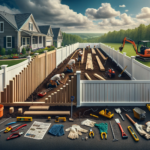Choosing the Right Fence Material
When it comes to installing a fence, selecting the right material is crucial. Each type has its own set of benefits and drawbacks, which can affect the overall look, durability, and maintenance requirements of your fence. Common materials include wood, vinyl, and metal. Wood fences are favored for their natural appearance and versatility, allowing for various styles such as picket or privacy fences. However, they require regular maintenance to prevent rot and insect damage. Vinyl fences, on the other hand, are low-maintenance and resistant to weathering, but they may not offer the same aesthetic appeal as wood. Metal fences, such as aluminum or wrought iron, provide excellent security and durability, though they can be more expensive. When choosing a material, consider factors like climate, budget, and the fence’s purpose to make an informed decision.
Understanding Local Regulations and Permits
Before commencing any fence installation project, it’s essential to understand the local regulations and acquire necessary permits. Municipalities often have specific rules regarding fence height, placement, and materials, which vary depending on the neighborhood and property zoning. Failing to comply can result in fines or the need to remove the fence. Contact your local zoning office or homeowners association to learn about these requirements. Additionally, some areas may require a survey of your property to ensure the fence is placed within your boundaries. This step is vital to avoid disputes with neighbors and ensure your fence adheres to legal guidelines. By doing your due diligence, you can avoid unnecessary setbacks and ensure a smooth installation process.
Planning the Fence Layout
Planning the layout of your fence is a critical step that influences both functionality and aesthetics. Start by determining the primary purpose of your fence—whether it’s for privacy, security, or decorative purposes. This will guide you in deciding the height and style. Measure your property accurately to determine the length of the fence needed and mark the boundaries clearly. Consider natural features like trees or slopes that may affect the installation. It’s also wise to discuss your plans with neighbors, especially if the fence will be shared. A well-thought-out layout not only enhances the look of your property but also ensures that the fence serves its intended purpose effectively.
Hiring a Professional vs. DIY Installation
Deciding whether to hire a professional or embark on a DIY fence installation depends on several factors, including budget, time, and personal expertise. Professional installers bring experience and knowledge, ensuring the fence is installed correctly and efficiently. They can handle challenges such as uneven terrain or complex designs, saving you potential headaches. However, this option can be more costly. On the other hand, a DIY installation can be rewarding and cost-effective if you have the necessary skills and tools. It allows for customization and personal involvement in the project. Consider your capabilities and the complexity of the project before making a decision. Whether you choose professional help or a DIY approach, proper planning and execution are key to a successful installation.
Maintaining Your Fence for Longevity
Once your fence is installed, regular maintenance is essential to ensure its longevity and appearance. Maintenance requirements vary depending on the material. Wood fences need periodic staining or painting to protect against weather and pests. Check for signs of rot or damage regularly and replace any compromised sections promptly. Vinyl fences require less upkeep, but occasional cleaning with soap and water will keep them looking fresh. Metal fences benefit from rust prevention treatments and should be inspected for any loose or damaged parts. By investing time in regular maintenance, you can extend the life of your fence and maintain its functionality and aesthetic appeal over the years.








